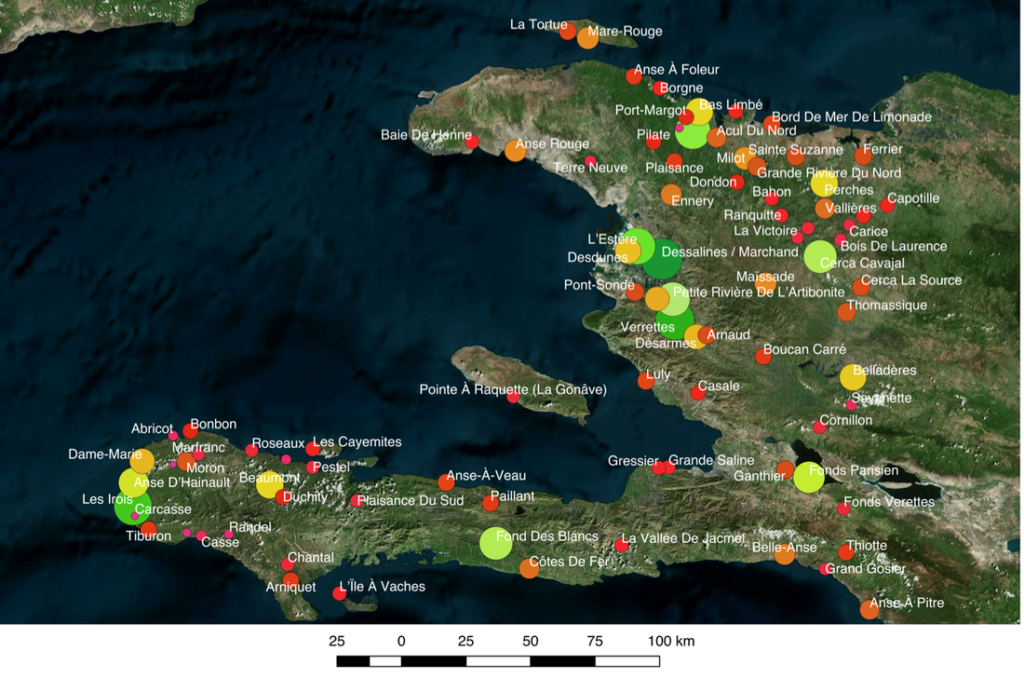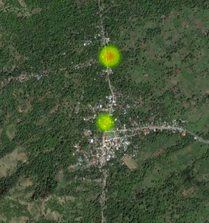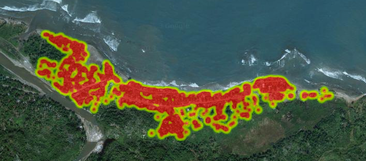By Alex Fisher | Associate
EarthSpark frequently talks about its goal of building 80 community microgrids in Haiti in the next 5 years, but what does it take to actually get those grids built? Critical elements of a microgrid development plan: knowing where those grids should go, what they should look like, and who the local champions will be. Other than hearsay and satellite imagery, however, there was very little credible data upon which to base such a plan in Haiti. EarthSpark’s recent undertaking – a national microgrid market study for Haiti – has illuminated the details of demand for electrification in rural Haitian towns.
EarthSpark International, Energy and Security Group, and The Haiti Energy Institute recently completed a countrywide market study of the potential for town-sized, solar-powered microgrids across Haiti. The study was conducted for EarthSpark’s Haitian social enterprise spin-off, Enèji Pwòp, S.A. in order to facilitate a fundable plan for microgrid development. Following a desk study of un-electrified Haitian towns, field research was undertaken in 89 rural towns from July-October of 2015.
Research Parameters
The study sample targeted towns with no or limited grid access. With the list of towns finalized, the surveys were designed with input from anthropologists, microgrid consultants, and energy policy advisors with a background in the Haitian cultural and energy contexts and focused upon the following research parameters:
· Energy demand / energy expenditures
· Private generation and appliance ownership
· Current political situation
· Strength of community organizations
· Town infrastructure and ease of accessibility (police station, bank, wire transfer services, roads, ports, etc.)
· Economic drivers and market activity
· Key crops
· Geographic distribution of buildings, town size / density
· NGO and Diaspora presence
Field Team
The field research team consisted of 20 teams of two researchers, hailing mostly from Haiti, Canada, and the US. Thanks to partnerships with three local universities, Université Quisqueya, Université d’Etat d’Haïti, and Enstiti Travay Sosyal ak Syans Sosyal, 30 Masters level Haitian students were recommended by the deans of their respective universities for research positions.
The partners ran a weeklong training session, or “microgrid bootcamp,” in Les Anglais, Haiti, home to EarthSpark’s first microgrid. The training included a multi-disciplinary curriculum on electricity, solar generation, survey methodology, and practice interviews.
Survey Methodology
Each research team used two Android tablets to undertake surveys of businesses, households, community leaders, and politicians. Based on their interviews and observations, the teams delivered qualitative and quantitative reports for each town. The survey questionnaires were uploaded using Open Data Kit software, to ease the collection and maintenance of data.
An in-house geospatial analysis of each of the towns was undertaken to determine the following: estimate of potential connections, building density, and flood risk. GIS tools used for the study were Google EarthEngine API and QGIS. This project also included a desk study of relevant laws, regulations and decrees relevant to micro-grid development and operation in Haiti, outlining opportunities and challenges.
Overall Results
Based on the survey information and geospatial analysis, towns were ranked based on their suitability as sites for solar microgrids. Rankings were based on scores in four categories: business energy demand, overall energy demand and fuel use, economic potential, and accessibility. Figure 1 illustrates the town rankings, with larger circles in green representing the towns with the highest potential score for microgrid suitability (and smaller, red circles representing towns with the lowest score). These results will help to inform the future of off-grid electrification in the country.
Town-Specific Results
Additionally, write-ups for each town based on all of the survey and mapping data were compiled as part of the final report for the study. Individual maps for each town, assessing the number of potential connections, the density of buildings, and the density of energy demand have been put together, where the relevant information is available. Figure 2 is an energy density demand map of Acul du Nord and Figure 3 is building density in Anse à Foleur,
Next Steps
With this information in hand, EarthSpark and Enèji Pwòp are ever closer to reaching the goal of building 80 microgrids across Haiti. However, process risk remains high for microgrid development in Haiti. Best practices for microgrid development remain anecdotal, and, while EarthSpark and others have gained some experience in the development of energy access microgrids in Haiti in recent years, there remain many gaps in the standardization of development and operation processes. From logistics to customs to legal structures, technology, and community engagement, many problems were encountered throughout the development of the recent microgrids in Haiti, and likely more unknown issues remain to be discovered during the development phase of the next grids. More good examples of successful microgrids in Haiti are likely necessary before developers will be able to attract investment capital to achieve microgrid development at scale.
To address these risks, EarthSpark is currently seeking grant funding to build upon its experience in Les Anglais by developing 3 additional microgrids. The next grid will be in the fishing town of Tiburon, less than an hour’s drive from Les Anglais. EarthSpark hopes to secure funding in 2016 and launch the Tiburon grid by July 2017. EarthSpark has secured a concession from the municipality of Tiburon for grid development and operations and has already conducted significant customer and infrastructure mapping.
Beyond Haiti, EarthSpark is now well positioned to leverage its research methodology and survey experience to undertake or facilitate similar market studies in other countries seeking visibility into microgrid development potential.
By Wendy Sanassee | Community Engagement Associate
By Rachel McManus | Executive Director
Project reports on GlobalGiving are posted directly to globalgiving.org by Project Leaders as they are completed, generally every 3-4 months. To protect the integrity of these documents, GlobalGiving does not alter them; therefore you may find some language or formatting issues.
If you donate to this project or have donated to this project, you can receive an email when this project posts a report. You can also subscribe for reports without donating.



